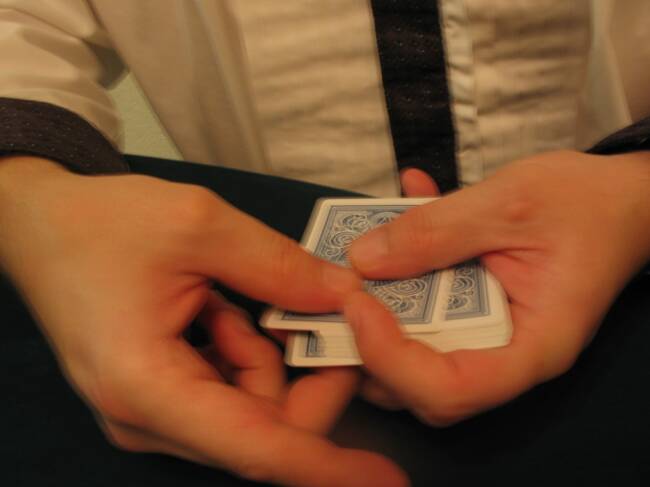Part Three : Nullifying the Cut and Dealing

After a cheat has managed to stack the deck and false shuffle, he must have a strategy to nullify the cut or his efforts will be foiled.
In euchre, offering the cut is rarely mandatory, or at least not usually enforced. Players often "forget" to offer it and even when they do offer, the opponents many times pass on the opportunity. Some circles even consider it bad luck to cut ("cut your own throat").
Natty Bumppo's book, "The Columbus Book of Euchre" describes a local custom of Columbus, IN called the "Columbus Cut". This is where the dealer completes his shuffle, slaps his hand palm down on the table and if the player to his right manages to strike his hand before he pulls back, he must offer the cut. Otherwise, the play stands as called.
Of course a cheater would prefer that the opponents don't cut the cards, but in actuality, a cut deck is only a small obstacle for a practiced cheat.
 | ||||||
"The Columbus Cut"
A fast handed dealer in Columbus need not worry about the cut.
Photo courtesy:
A. Methods of Nullifying the Cut
1. Non-offer - This one is obvious. When someone shuffles and then immediately starts dealing, the player to the right will sometimes mention it, but often pass on the late offer if the dealer seems sincere.
3. The Bottom Hold-out - Assuming that the dealer has 4 cards stacked on the bottom of the deck and the player to the right is likely to cut. The dealer can palm a batch of cards (at least 4 and face down) from the bottom of the deck in his left hand while his right hand puts the rest of the cards in front of the opponent to cut. After the cut, the dealer picks up the deck with his right hand and puts it back into his left on top of the original "stack".
4. Hops and Shifts - There are many ways to hop a cut. Hopping a cut is a method of manipulating the two halves of a cut deck back to it's original position by use of sleight of hand. The techniques usually require a lot of practice and are difficult to describe (remember, this is not a "how to cheat" instruction manual anyway), but I will briefly describe a couple of methods strictly as examples.
a.) Off the Table - In a friendly card game, this move might actually look exactly like what the other players are doing with legitimate intentions. It works like this; The cheat shuffles the cards and offers the cut. The opponent cuts the cards. The cheat sweeps the former top half off the table into his left hand (which is sort of cupped at the table edge) and then appears to sweep the other half on top of it in the same manner. In actuality, the cheat pushes down on the rear corner of the first half with his thumb (slightly lifting the front) and quickly slides the second half underneath with the right hand covering the move.
b.) Two handed -After the opponent cuts, the dealer (who has culled 4 cards to the bottom) uses two hands to put the deck back together. The half that is supposed to go on top (the former bottom half containing the 4 card stack) is picked up in a manner where a few cards at the bottom (at least 4) can be riffled off and slid below the other half. With practice and correct finger positioning, the move can only be visible from the dealer's point of view.
1. Never allow players to remove the deck from above the table in plain view.
2. Tell the opposing dealer to complete the cut with one hand if you suspect that he is cheating (or complete the cut yourself).
B. "Dirty" Dealing
1. "Base Dealing" - Dealing off the bottom of the deck, or "base dealing", takes hours of rigorous practice in order to look convincing. Not everyone has the required hand dexterity to do it well, but euchre comes with a built-in advantage for the cheater; the cards are dealt in batches of 2's and 3's. This fact alone simplifies an otherwise very sophisticated cheater technique a thousandfold. A base dealer that is required to deal the cards one at a time to each player must work very hard to make a smooth transition from dealing the top card, switching to the bottom and then back again. The deck must be held in the "mechanics grip" to allow easy access to the bottom card and a method of pushing out the card from bottom needs to look almost exactly like the one used when dealing the top card. The cheater must even perfect the sound of the cards coming off the deck if he values his well-being. He will often choose to deal the cards off the top in the same snappy fashion to make it difficult to notice the difference. When he goes to deal his (or his partner's) cards, he'll elevate the deck slightly with his pinky, push off the top card with the left thumb, and reach the right middle finger down between the left first and second fingers and snatch the bottom card, left middle and ring fingers briefly opening to release the card. The thumb hangs on to the top card and very quickly pulls it back in place as the bottom card is pulled out and dealt. When a dealer has retained a 4 card stack at the bottom of the deck, and they have survived the shuffle and the cut, all he has to do is deal a batch of 3 cards off the bottom to himself. The last card at the bottom will be used later as the turn-up card.
2. Second Dealing - Being capable of dealing the second card from the top in a euchre game is simply not as valuable an asset as dealing from the bottom. Second dealing requires considerably more skill to accomplish and only retains one selected card at the top. However, a very skilled cheater might stack his four cards at the bottom intending to base deal himself a winner and discover yet another useful card by using a peak method and retain it on top of the deck. He deals batches of two to the first three players, all from just below the top card. When he gets to his own hand, he gets the top 2 cards. Next round, he gets the batch of 3 from the bottom and turns up the fourth. This guy has just dealt himself a loner! You won't run into great second dealers playing euchre very often however. These guys are usually too busy ripping off high stakes gin and poker games and such.
3. The Turn - A dealer that has dealt himself 3 of the 4 cards that he has stacked at the bottom must make sure that the fourth becomes the up-card, otherwise he has probably done himself more harm than good. Think about it. If you deal yourself the jack, ace and king of spades and then turn up a heart, you're in trouble. The problem is, when the cards are dealt out, 4 are left on the bottom and the one that the cheat needs to turn up is on the bottom of these. The solution is simple. The dealer spreads out the last four cards as if to count them (as many experienced euchre players do) then, in one fluid motion, squares them back up and pinches the edge of the bottom card with his right thumb and index finger and flip it all the way over on top of the kitty. The move is practiced to exactly imitate what the dealer does when he is actually flipping the top card over.
note: It is funny to watch a pissed off cheater turn-up the former left bower from the previous hand, making all of his work useless!
1. Watch for these mistakes often made by base dealers;
a.) Grabbing Air - When he holds the deck too tight, the bottom card doesn't come off and it looks like he is dealing an invisible card.
b.) Hangers - When he holds the deck too loose, the bottom card comes off, partially followed by the card just above it, which will be left hanging out of the bottom of the pack.
2. A Second Dealer will often squeeze the deck rather hard, sometimes bending it slightly. His thumb will not move, and neither will the top card throughout the deal.
3. If you always pay close attention to the entire deal from the time the dealer gets the cards up to and including the time that he turns the up-card up, you will most likely deter cheaters from making their moves on you.
NEXT:


Second Dealing
2. Stalls - A stall is a method that involves a distraction during the action of putting the deck halves back together after the cut. When performed properly, the opponents will often fail to realize that the deck was put back together exactly the same way that it was before the cut. Although there are infinite means to pull this move off, the most deceiving forms involve misdirection. Here is an example; The dealer offers the cut. The opponent cuts the deck. The dealer picks up the original bottom half into his left hand then suddenly moves an object (ashtray, drink etc.) from his right side (with his right hand) over to his left side. While all eyes are still focused on the object he just moved, he swiftly picks up the original top half and places it into his left hand on top of the other half (fully restoring the deck's original order) and commences to deal the cards. This move is actually very deceiving as long as the dealer never focuses his eyes on the cards. That is the most important part of using misdirection. The other players will tend to follow the eyes of the cheat to the object that he is moving and then lose track of the order of the cut.
c.) The Ripper - I don't know what else to call this move. When I was at a supervisor training class at a casino I used to work for, I witnessed a professional card cheater demonstrate this move. After seven years of practicing the move myself, I admit that I can not perform it nearly as quietly as he did. When this move is performed correctly, it appears that the cheater offers the cut, completes the cut, squares up the deck and starts dealing. In actuality, the cards are all still in the same position that they were prior to the cut. Even to someone watching very closely, this move is virtually undetectable. It works like this; The dealer offers the cut. After the cut, the dealer appears to complete the cut correctly, only, he bookmarks the corner closest to him with his right thumb as he picks up the deck. This "bookmark" holds a small gap between the two halves of the deck. As he places the deck into the left hand, he begins to lift the top half of the deck up in the back as the right hand covers the move. At one split second, it appears from the opponents point of view that he is squaring up the deck in his left hand while he actually curls his left hand fingers up and pulls the entire top half of the deck to the bottom, switching the two halves back.

